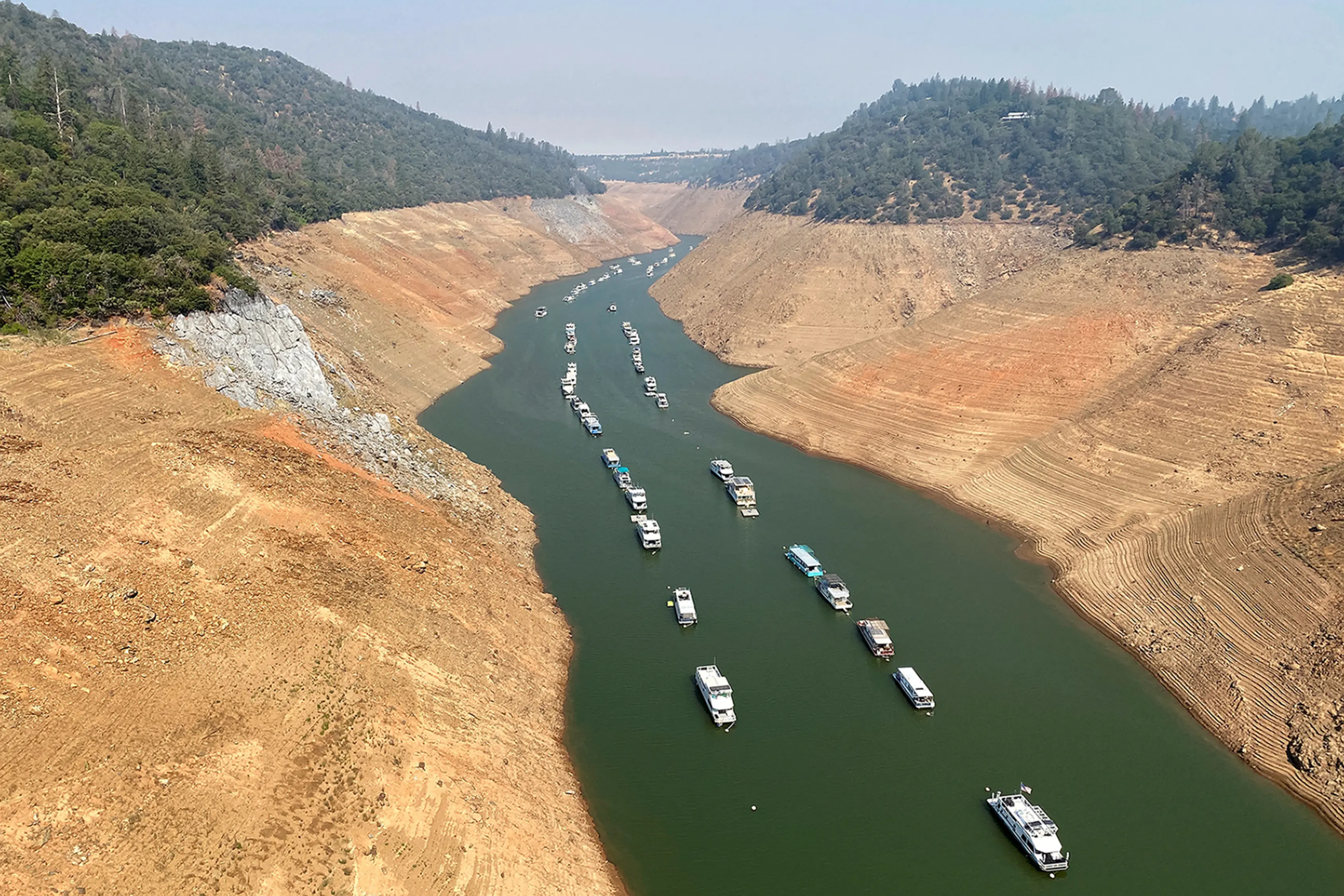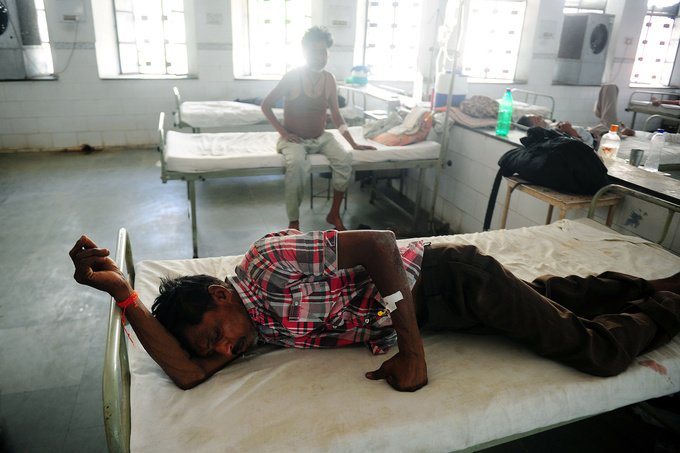A World Overheating
Longer and more intense heat waves have become a regular feature of the worsening climate crisis. See the damage they’ve caused and how governments are adapting to unavoidable extremes.
Scientists agree that longer and hotter heat waves are among the most certain impacts of climate change. The sustained record-breaking temperatures that have plagued certain regions of the world in recent years are a sign of a rapidly warming planet and a preview of how heat extremes will continue to intensify.
Extreme heat threatens the lives and livelihoods of millions of people around the globe. It kills people, damages infrastructure, and exacerbates food insecurity. Developing nations and low-income communities frequently bear the brunt of extreme heat’s impacts yet have the least resources to cope.
There is growing recognition among policymakers, business leaders, and citizens that the world needs to adapt to withstand worsening heat. This aspect of the climate crisis will feature prominently in negotiations at this year’s UN conference, the twenty-sixth Conference of the Parties (COP26), in November.
How Climate Change Worsens Heat Waves
The earth’s average temperature has risen more than 1°C (1.8°F) since the 1880s due to soaring greenhouse gas emissions caused by human activity. Scientists say this higher level of heat has contributed to worsening weather extremes, including hotter and longer heat waves and extended droughts.
Some areas of the world are heating more rapidly, including the Arctic, which is warming at least twice as fast as the rest of the planet. More than one-fifth of the global population now lives in regions that have already experienced warming greater than 1.5°C (2.7°F), an increase that almost all nations have agreed should be avoided to significantly reduce the risk of harm from climate change.
Even if global warming is limited to 1.5°C above preindustrial levels—the goal set in the Paris Agreement—thirty to sixty million people [PDF] live in areas where the average temperature in the hottest month would be too high for a human body to function healthily.
However, the world is currently on a path that will take it high above 1.5°C: temperatures are estimated to exceed 3°C (5.4°F) of warming by 2100. Some regions, such as the Middle East, anticipate 4°C (7.2°F) of warming by 2050 if emissions continue unabated. By 2050, more than 70 percent of people worldwide could experience severe heat waves.
In the United States, one assessment found that the length of heat waves in many urban areas has already increased by forty days on average since the mid-twentieth century. The United States could endure an additional 70 percent increase in the number of days with the heat index above 90°F (32°C) by 2050 based on current levels of greenhouse gas emissions. Additionally, without any changes in population, the number of people experiencing thirty or more days with a heat index above 105°F (40°C) in an average year will increase from just under nine hundred thousand to more than ninety million [PDF]—nearly one-third of the U.S. population—according to the Union of Concerned Scientists.

Climate models project that, by the end of the century, heat waves will routinely shatter records and increase heat stress on populations globally. These record-breaking temperatures will threaten millions of lives. According to Columbia University’s Earth Institute, global warming could kill as many as eighty-three million people over the next eight decades, a population equivalent to Germany’s.
Health and the Wet-Bulb Temperature
More frequent and intense bouts of extreme heat endanger human health by increasing heat-related illnesses, such as heat stroke, and ultimately lead to more deaths. In the United States, heat waves already cause more fatalities than any other type of severe weather event.
One factor that contributes to more deaths is what is known as the wet-bulb temperature. Exposure to a sustained wet-bulb temperature of 35°C (95°F), a point of intense heat and humidity, has been identified as the limit for human survival. When wet-bulb conditions develop, sweat can no longer evaporate off a person’s skin and the body cannot cool down. Just a few hours of this kind of heat exposure can lead to death.

The likelihood of reaching this critical threshold has increased due to climate change. Some regions, including southwestern North America, South Asia, and the Middle East, have already endured conditions at or near this limit, and certain areas will experience the effects more intensely than others. One projection indicates that, by 2030, this type of heat wave could afflict two hundred million people in India alone.
Lower-income communities and developing nations are most vulnerable to heat-related illnesses and deaths due to their geographical location, deforestation, and lack of access to resources, such as air conditioning and cooling centers. Less than one-third of global households have access to air conditioning, according to the International Energy Agency, and only 8 percent of the 2.8 billion people living in the hottest parts of the world have air conditioners.
Heat also kills unequally. Death rates are highest for elderly people and those who are socially isolated. Children, pregnant women, and people living with chronic conditions, including heart disease and mental illness, face heightened vulnerabilities.
Laborers who work primarily outdoors are at greater risk of heat-related sickness. Migrant farmworkers in the United States are particularly vulnerable because incidents among undocumented workers are less likely to be reported.
Infrastructure Failures
The infrastructure of today was not built to withstand surging temperatures. More frequent and severe heat waves stress major systems, including power and transportation infrastructure.
Heat is taking a heavy toll on the power grid. Increased demand for electricity to run air conditioners at times exceeds the capacity of power plants, causing the electric grid to falter. Hotter weather can lower the amount of energy that power lines transmit and cause them to sag. Additionally, high temperatures can limit electricity production when the water used to cool power plants becomes too warm. Heat can also lead to drought, which in turn can cause water levels to fall too low for hydropower plants to operate.

The transportation sector suffers as well. Heat expands concrete, causing sections of road pavement to buckle. It causes steel-comprising drawbridges to expand, hindering their ability to open and close. Train tracks form “sun kinks” as the metal tracks bend under intense heat, increasing the risk of derailment, as occurred in the 2019 European heat wave, resulting in train cancellations across the continent. Planes can struggle to fly in high-heat conditions, and extreme temperatures can reduce the allowable weight of aircrafts to takeoff. This increases the likelihood of disruptions to travel and shipping for passengers, manufacturers, and airlines alike.
Urban communities are disproportionately affected due to the “urban heat island” effect, when a city’s buildings and pavement amplify the severity of heat. On a hot day, the sun can heat exposed urban surfaces [PDF] to temperatures between 27°C and 50°C (50°F and 90°F) warmer than the surrounding air, the U.S. Environmental Protection Agency found. Urban areas can experience daytime surface temperatures up to 15°C (27°F) higher than their rural surroundings.

Urbanization will only increase vulnerability. More than half of the world’s population already lives in metropolitan areas, and by 2050, this proportion could rise to 68 percent.
Food Insecurity
Extreme heat threatens the food security of billions of people by hampering crop production, livestock viability, and fishing sustainability. Yet, by mid-century, agriculture will have to produce nearly 50 percent more food to feed the world’s growing population.
Over the past several years, heat waves and drought have caused an estimated 20–50 percent losses in crop yields globally. A 2018 heat wave cut agricultural yields by half in areas across Central and Northern Europe. More than one-third of the world’s agricultural land that cultivates wheat and rice—crops that constitute nearly 40 percent of the average individual’s diet—could endure devastating heat waves of five days or more by 2050.
When temperatures surpass optimal growing conditions, crop production shrinks, and the risks of pathogen and weed infestation grows. A virus or weed that was previously unable to thrive in a certain area could find the new climatic conditions ideal.
Already, large-scale crop failures due to extreme weather conditions including heat and drought are driving malnutrition worldwide. Less-developed countries, in particular, have begun to experience the damage. For example, Africa’s Sahel region is warming approximately 1.5 times faster than the global average. For countries within the region, extreme temperatures have combined with reduced water availability to cause widespread land degradation. In Mali, drought and extreme temperatures caused nearly three hundred thousand people to experience food insecurity in 2015.
Rapidly rising temperatures also endanger marine life, with fish stocks declining as oceans warm. One study found that the amount of fish humans can sustainably harvest shrank by over 1.4 million metric tons between 1930 and 2010.
Learning to Adapt
In the decades ahead, a changing climate will contribute to more frequent and more severe heat, even if emissions plunge to zero. Nations should rapidly reduce their emissions; meanwhile, governments, communities, and businesses have begun the essential task of adapting to these worsening heat waves.
A clear place to start is increasing preparedness by creating heat adaptation plans. France has been a leader in this respect. Since an unprecedented heat wave in 2003 that killed nearly fifteen thousand people, France has become one of the world’s most heat-prepared nations. Its National Heat Wave Plan, implemented the year after the heat wave, has cut the nation’s death toll from heat waves by 90 percent. Robust early-warning systems form a critical element of the plan: ahead of a heat wave, the government circulates posters, flyers, radio and TV campaigns, and internet ads to alert citizens of the impending heat and offer survival strategies. Early warnings based on accurate forecasts ensure that the population has ample time to prepare.

City leaders should focus on reducing the severity of urban heat islands. The city of Ahmedabad, India, developed a Heat Action Plan in 2013, which has served as a model for the rest of the country. The plan includes strategies for implementing detailed early-warning systems, building public awareness of heat risks, and training health-care workers to manage increased heat-related illnesses. Miami installed the world’s first chief heat officer, and other cities plan to follow suit.
Climate-smart agriculture can increase crop resilience to high heat and reduce the risk of food insecurity. The World Bank pledged in its first Climate Change Action Plan (2016–2020) to work with countries “to deliver climate-smart agriculture that achieves the triple win of increased productivity, enhanced resilience, and reduced emissions.” In the private sector, agritech companies such as Bayer Crop Science have been developing innovative agricultural solutions, such as hybrid seeds for corn and soybean crops, to help farmers adapt their harvests to high temperatures. Strengthening insurance coverage to buffer populations from costs due to rising heat will also help absorb heat-related economic shocks.
An additional measure that could prove valuable is to name heat waves. Meteorological centers around the world already name tropical storms and cyclones. Similar regional or country-specific organizations could assign names to anticipated heat spells. Not only do names enable clear identification of an impending danger, they also provoke authorities and citizens to take immediate action to prepare.
Nations should weatherproof their infrastructure systems to withstand the extremes of the future. For transportation systems, this will require retrofitting roads and bridges with more heat-tolerant materials.
Additionally, expanding the availability of air conditioners will help communities cope with more frequent surging temperatures. At the same time, efforts should be made to minimize the demand for cooling to avoid overwhelming power systems. To reduce demand, cities can implement conservation strategies, such as the installation of “cool roofs,” which reflect sunlight and prevent heat absorption. Construction practices that include effective insulation and prioritize green spaces will also help mitigate heat impacts on communities.
Though countries have taken some initial steps, they will have to do more to adapt to unavoidable heat extremes fueled by a changing climate. The COP26 in Glasgow will serve as a crucial forum to establish greater ambitions for global climate action. To enable all countries to successfully mitigate and adapt, developed nations will need to ensure developing countries receive adequate climate finance. Reaffirming the $100 billion climate finance commitment during these negotiations is an obvious place to start. Developing countries will need this funding to build resilience to worsening heat waves through measures such as building and retrofitting resilient infrastructure, expanding access to cooling systems, and establishing effective early-warning systems.
Nations will have to increase cross-border cooperation at all levels to meet this goal and accelerate global climate adaptation efforts. And, even as countries ramp up these vital efforts, they should continue to meet ambitious emissions-reduction targets to avoid the very worst heating.
Will Merrow created the graphic for this article.
 Online Store
Online Store










